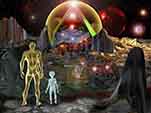A post submitted by CGI member Leathur.
**************************************
Regulus, the Star at the Center of the Zodiac
Bob Berman
July 21, 2023
On Friday, July 28, 2023, soon after sunset, see a strange and wonderful spectacle. The orange planet Mercury will form a close pair with the famous blue star Regulus! Here are viewing tips, plus learn about the remarkable Regulus, the “little king” of the stars.
How to See Regulus
On July 28, you’ll need an unblocked western horizon. After sunset:
Look first very low near that horizon for the elusive orange planet Mercury which is the brighter of the two at +0 magnitude.
Then look very, very close to Mercury (only 0.1 degrees apart!) for the famous blue star Regulus (+1.3 magnitude). They form such a close pairing that they’re about the equivalent distance of 1/5 the diameter of a full Moon!
Binoculars will make the pastels pop. But such optical aid is icing on the cake: anyone visually searching the low western horizon will see that striking planet-and-star combo just as twilight begins to fade.
Regulus is one of the brightest stars in the night sky. And while it appears as a single star to the human eye, Regulus has three unseen companion stars, two of which can be seen in telescopes.
Regulus is also the brightest object in Leo. The “Sickle of Leo” makes up the lion’s mane and looks like a backward question mark of stars.
Regulus sits prominently at the base of that “sickle” or reversed question mark, all of which makes Leo one of the relatively few constellations that actually resembles what it’s supposed to portray.
Regulus, the Little King
The lion, of course, represents the noble king of the beasts. And Regulus means “little king” in Latin.
Regulus has been famous through the ages, regarded by the ancient Persians, for example, as one of the “four royal stars.” The “little king” was viewed as the most important of the Four Royal Stars of the Persians, which marked the seasons.
Its fame is largely due to its position almost smack on the ecliptic, the center of the zodiac! This means that as the Sun circles around the sky each year, passing repeatedly in front of the same constellations that were deemed super special for untold thousands of years, it comes closer to Regulus.
The Sun’s motion against the stars is of course due to Earth orbiting around it, giving the Sun a different daily background from our perspective as it shifts one degree (two Sun-widths) per day. We never actually see this because the Sun’s brilliance makes the sky blue and renders invisible everything behind it. Only during a total solar eclipse can we view the stars behind the Sun.
Yet the ancient Babylonians, 4,000 years ago, observing the stars somewhat near the Sun each day just before dawn and again at nightfall were able to determine the Sun’s daily path and position to a high degree of precision. They discovered the constellations through which the sun passed and called them the zodiac. And they knew that only six bright stars in a few of those zodiac constellations could ever appear next to the Sun, Moon or planets. Of those, Regulus in Leo the Lion was far-and-away the closest star to the Sun’s precise yearly path, the ecliptic.
Look for Regulus again on August 22
CONTINUE READING: https://www.almanac.com/remarkable-star-regulus













 ^
^



 ^
^


























